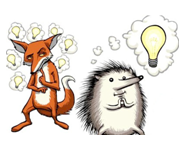 Predictions are tough, especially when they involve the future.
Predictions are tough, especially when they involve the future.
Yogi Berra
Philip Tetlock, professor of psychology at the University of Pennsylvania, is a rock star to statistics geeks but less well known by the general public. Newly tenured at UC Berkeley in 1984, Tetlock began a twenty-year study in which 284 experts in many fields – government officials, professors, journalists, and others, and with many opinions, from Marxists to free-marketeers, were asked to make 28,000 predictions[1][2] about the future. His major finding: they were only slightly more accurate than chance. One of his studies revealed that when political scientists claimed that a political outcome had absolutely no chance of occurring, it nevertheless happened about 15% of the time. In finance, we recall the Forbes columnist who singled out AIG as one of his four top stocks to buy in January of 2008[3] shortly before its liquidity crisis that required that nearly wiped out investors and required a federal bailout.
It’s not news that predictions are flawed. More than a hundred studies have been conducted that pitted experts against statistical or actuarial formulas, and in almost all of those studies the people either do no better than the formulas or do worse. In one, data from a test used to diagnose brain damage were given to a group of clinical psychologists and their administrative assistants. The psychologists’ diagnoses were no better than the assistants [4].
But some experts are worse than others! The metaphor begins with an essay published in 1953 by the philosopher Isaiah Berlin titled “The Hedgehog and the Fox”. Hedgehogs have just one powerful response to a threat, rolling themselves into a ball and presenting their spikes to predators. Foxes, by contrast, have no single response to challenges, for they ‘know many little things’. They react to challenges by drawing on a pattern of general, pragmatic understanding, often making mistakes but seldom committing themselves to a potentially catastrophic grand strategy. Professor Tetlock adapted these two cognitive styles to mark the opposite ends of the scale of prediction styles. Hedgehogs are more sure of themselves, needing closure in order to feel happy. “That’s settled then”. Foxes are less committed to their beliefs, more tolerant of dissonance within their models (the enemy regime might have some redeeming qualities) and are more likely to change their minds.
Even though Hedgehog type predictors make worse predictions as a whole, they get more attention because they make better TV guests! Unwavering confidence appears more convincing, whereas nuanced, more thoughtful prognosticators appear less sure of themselves and can be dismissed as “flip floppers”.
Knowing one’s own cognitive style can be a great help in resisting the pull of poor predictions. After all, we are naturally more likely to want to agree with someone who things like we do, who “speaks our language”. Want to know if you tend toward the Fox or Hedgehog? You can take a very simple assessment here. Cognitive styles are not character flaws; they are just different ways of thinking about things and dealing with challenges. Once you know your own style, you can adjust for any biases you might have.
We have long embraced the philosophy that forecasting adds little value to investing. Our approach to dealing with the unexpected is to be flexible and nimble in our ability to respond while continuing to attempt to capture market returns.
- ^ Bialik, Carl (6 January 2006). “Evaluating Political Pundits”. The Wall Street Journal. http://online.wsj.com/public/article/SB113631113499836645.html?mod=2_1125_1.
- ^ http://longnow.org/seminars/02007/jan/26/why-foxes-are-better-forecasters-than-hedgehogs/
- “We’re Too Gloomy”, Ken Fisher, Forbes, January 2008. http://www.forbes.com/forbes/2008/0128/106.html
- “Expert Political Judgment: How Good Is It? How Can We Know?” by Philip Tetlock

